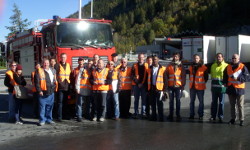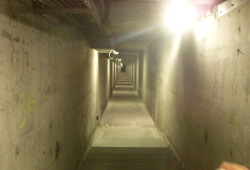 |
 |
|||||||||||||
|
|||||||||||||
|
|||||||||||||
|
Tiny particles, producing brilliant collisions as they race around an underground tunnel, are the stars of an accelerator. It's easy to forget that people, too, must make their way around the tunnel, and that their protection merits as much attention as do flying bits of matter. To see one example of tunnel safety done right, scientists and engineers in the linear collider community took a tour of the Mont Blanc tunnel earlier this autumn. The road tunnel, an 11.6-kilometre thoroughfare that connects France and Italy, is a model of safety in civil engineering. “The Mont Blanc safety system is very effective and versatile,” said Vic Kuchler, head of the ILC Americas Conventional Facility and Siting Group (CFS) and coordinator of the global CFS effort. “It represents the same kind of thing we're trying to do for the ILC.” Though the tunnel for a future particle collider will not direct automobiles through a mountain base, the tour was nevertheless useful for the scientists, offering an up-close view of the safety features for a project of similar magnitude. It also provided them with lessons that previous engineers had learned the hard way. “The Mont Blanc tunnel disaster had a huge impact on tunnel design all over the world,” said John Osborne, ILC European leader for the CFS, based at CERN. In 1999, a lorry transporting margarine through the Mont Blanc tunnel caught fire. Temperatures exceeded 1000 ℃, and no one could enter the tunnel for five days. Thirty-nine people perished. The French and Italian governments spent the next three years and $480 million rebuilding the tunnel. “What struck me was how difficult it was to go through that after the fact,” Kuchler said. “To retrofit the tunnel to the level of safety it now has was very costly and time-consuming.” Now, it is outfitted with almost every imaginable safety valve – outs for pollutants, outs for gases, outs for people. A ventilation duct that runs the length of the tunnel beneath the street gives extracted smoke a place to go. An oxygenated escape tunnel, also beneath the street, allows people to walk to safety. And in the control room, tunnel personnel can track temperatures, pressures and air quality with the help of a giant monitor that displays a continually updated electronic blueprint of the passage. “It's a bit crazy, really,” Osborne said. “What's all that got to do with our ILC project? But there are similarities between the two.” One similarity is the possible inclusion of emergency alcoves, regularly placed refuges where people can take shelter away from harmful elements. In the Mont Blanc tunnel, these bright green shelter entrances are positioned every 300 metres on either side of the roadway. The shelters house videophone links for communication with safety operators and also offer passage to the escape tunnel. For a linear collider, the alcoves would also provide protection from radiation. “We're already considering, with the Compact Linear Collider Study for example, a fire barrier every 500 metres to allow escape into a safe zone,” Osborne said. Another similarity is the ventilation system. For many major components of an accelerator beam pipe, helium is the cooling agent. For the unlikely event of a leak, a helium-extracting ventilation system will be developed to suit the specific tunnel configuration for each site being considered. A proposal for extracting a different hazard, smoke, compartmentalises the collider tunnel in the Asian and European Regions along its length for tighter control of air pressure and to create fire barriers. Air is pumped in from the ceiling while smoke is extracted. In the Americas Region, smoke will be extracted using exhaust fans as part of the overall ventilation system. Scientists may take other cues from the Mont Blanc tunnel model, but only cues. For while everyone in the tour group was impressed with the Mont Blanc example, it was not inducement to copy the tunnel vent for vent. “We're not the same as a traffic tunnel,” Osborne said. “We have a particle accelerator, so we have to use our good judgment, absorbing what we've learned here, but also applying what we've done before with other particle accelerator projects.” An accelerator tunnel won't carry the same risks as a road tunnel since, for example, flammable cargo-carrying vehicles won't move through it. Though an accelerator tunnel is less hazardous, one can't be too careful. “People are in the tunnel usually only during installation or maintenance,” Kuchler said. “But if you're someone who's the tunnel during those few hours a year, you're going to be very happy that during the initial design process, someone took the time to think about safety.” -- Leah Hesla |
|||||||||||||
| © International Linear Collider |

